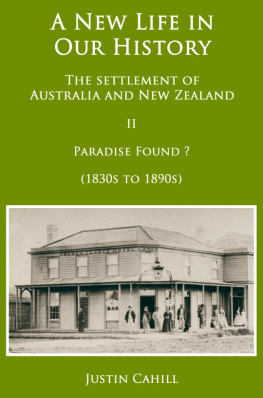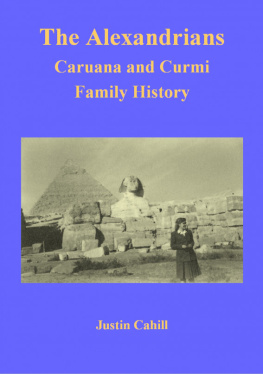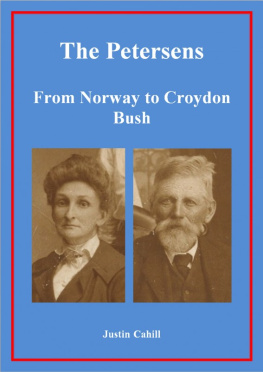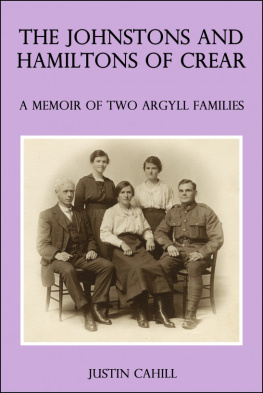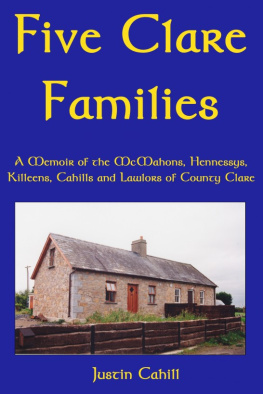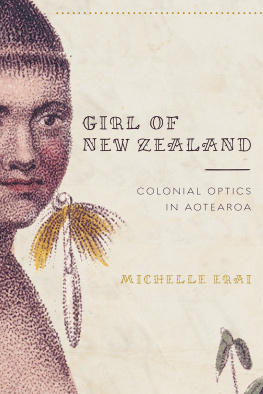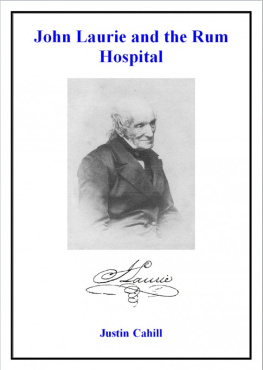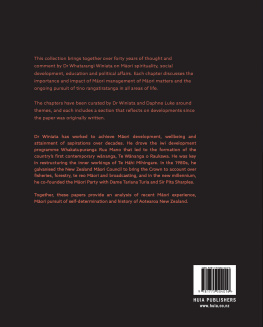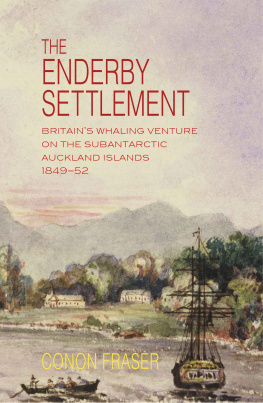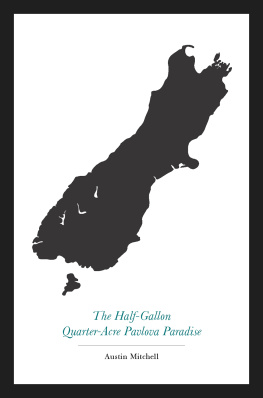A NEW LIFE IN OUR HISTORY
THE SETTLEMENT OF AUSTRALIA AND NEW ZEALAND
II
PARADISE FOUND ?
(1830s to 1890s)
Justin Cahill
Smashwords Edition
Copyright 2014 Justin Cahill
Smashwords Edition, License Notes
This ebook is licensed for your personal enjoymentonly. This ebook may not be re-sold or given away to other people.If you would like to share this book with another person, pleasepurchase an additional copy for each recipient. If youre readingthis book and did not purchase it, or it was not purchased for youruse only, then please return to Smashwords.com and purchase yourown copy.
Please direct all inquiries to Justin Cahill at
PO Box 108, Lindfield, 2070
New South Wales, Australia
or e-mail to jpjc@ozemail.com.au
As many worlds had been colonised for idealistforms of government
as for purely commercial considerations. The guidingprincipal of
foundation could not yet be considered the necessarycriterion for a
successful subculture. The variables involved weretoo numerous.
- Anne McCaffrey, Killashandra , 1986.
Cover illustration: Photograph of the GoldenFleece at Invercargill with Mary Lang, dressed in black in thecentre, and others standing outside.
oOo
CONTENTS
oOo
INTRODUCTION
This is the second part of A New Life in OurHistory, an account of the settlement of Australia and NewZealand told from the perspective of ordinary people. The firstpart, The Fatal Shore ?, covered the transportation ofSolomon Bockerah to New South Wales on the Second Fleet and thelives of Ann and Sarah Bockerah with Richard Atkins, the Colonyssometime Deputy Judge Advocate. It also followed the Laurie family,who provide a classic example of how the Colony was not always thefatal shore the British government hoped it would be.
This part describes how the colonial reformers,particularly Edward Gibbon Wakefield, hoped to provide a moreenlightened solution to Britains increasing levels of poverty andunemployment. It centred on establishing colonies intended to besocial paradises in which everyone had a chance to supportthemselves and get ahead. It also covers the Lauries days atKawhia, their dealings with the local Mori and how the differencesbetween Mori and Pkeh expectations of British settlementultimately led to war - shattering the reformers efforts topromote the new settlements. Its outcome is told from theperspective of the Lauries distant relative, Wiremu Te MrehuMaipapa Te Whoro.
It also follows the experiences of two familieswho immigrated to New Zealand, the Langs and Nicholsons. The Langs,in search of new opportunities, were selected to be among the firstsettlers of Canterbury. The Nicholsons, by contrast, were rescuedfrom famine and the infamous Highland Clearances and shipped to thenew colony of Victoria. The Otago gold rush ultimately brought theNicholsons from Victoria to New Zealand. The Langs, having madetheir fortune sheep farming, also moved to Invercargill.
Gold, and the war in the North Island, alsobrought the Edwards, a branch of the Laurie family, to the SouthIsland. They were eventually joined by the Biggar and Harlandfamilies. The Biggars personify the choice facing many immigrants:where to go ? The family of Catherine Biggars brother, PeterMcKay, had chosen Minnesota - which turned into a war zone when theSioux Wars erupted. The Biggars chose the more distant, but saferoption of the Free Kirk settlement at Otago. After initiallysettling in Victoria, the Harlands also came to Otago.
The arrival of the enigmatic Norwegian seafarer,Peter Petersen, in about 1878 rounds off the arrival of theprogenitors of the families included in this book.
The new societies threw up challenges of theirown. The Langs, having opened the Golden Fleece Hotel, foundthemselves firmly in the sights of the local prohibition movement.Others, such as the Edwards and Biggars, having moved to whereverthey could find work, looked for a place to settle their growingfamilies. How these contingencies brought them to Croydon Bush andhow they established themselves there is told in part three,Crimson Ties.
oOo
1. A newvision
i
At the time the Lauries left Sydney, the Britishgovernment was under increasing pressure to implement a systematic,long-term solution to unemployment and poverty. Previously, it hadhoped to deal with them by passing laws to protect property andtransporting many of those who broke them to New South Wales andVan Diemens Land in Australia, the fatal shore that was supposedto deter further crime. But by the 1830s it was clear that this wasnot an adequate solution. Transportation did not deal with theactual causes of unemployment and poverty. Many of the convictswere professional criminals who were unlikely to be deterred by thechance they would be caught and punished. Some of those transportedto Sydney, such as John Laurie, had established comfortable livesthere, creating the impression that it was a land ofopportunity.
While the government implemented some of Biggesrecommendations, it remained ambivalent about New South Walesfuture. Ultimately, its failure as a deterrent to crime andworsening domestic unemployment and poverty would prompt the end ofits time as a penal colony. The idea of a fatal shore would giveway to building new, model societies in its place
ii
In Solomon Bockerahs time, enclosure and themechanisation of agriculture were gathering momentum. Although theyresulted in some unemployment and social disturbance, their effectswere muted. But by the 1830s, the situation had changeddramatically. The full impact of these developments was now clear.One of Meikles threshing machines, for example, could put ahundred men out of work during the harvest. The economy remaineddepressed, exacerbating the situation. Prices, including the costof staples such as wheat, remained high while wages stayed low.
There was a very real prospect of a revolution.As ordinary people had no voice in government, riots broke out insome areas. In 1830, rural workers in southern and eastern Englandprotested against machines and demanded higher wages. Some farmersreceived letters threatening their lives if they bought threshingmachines or did not get rid of the ones they already had. Many weresigned by Captain Swing, the figurehead made up by the rioterswho gave his name to these events the Swing Riots.
Greys Whig ministry reacted harshly. Itprosecuted almost 2000 rioters, with about 252 being sentenced todeath. But it was not interested in creating political martyrs.Most of the rioters were pardoned and had their sentences commutedto prison or transportation. While nineteen were hung, about 481were sent to Australia.
iii
Hanging the unemployed and hungry has neverproved to be a long-term strategy for governing. Greys ministryhoped to prevent any revolution by extending the vote to give morepeople a say in governing the nation. Parliament passed theReform Act of 1832. It was not much of an improvement. TheAct gave the vote to men who lived in towns and occupied propertywith an annual value of at least 10. But this excluded about sixout of seven men, including most of those who participated in theSwing Riots, and all women from voting. It also excluded most ofthe growing numbers of people who lived in the growing towns andcities. This unrepresented majority now demanded reform in twocrucial areas: the Poor Laws and the Corn Laws.
Up until 1834 people who relied on poor reliefhad a choice. Those who could look after themselves lived in theirown homes and were paid a dole by the parish authorities. Those whowere too ill, disabled, young or old to work could fall back on thealmshouses, hospitals, orphanages or workhouses. The Annings, forexample, had the choice of staying in their home and receivingthree shillings worth of poor relief each week or moving to aworkhouse where they would be provided with food and board. But, inthe brave new world of the 1830s, attitudes had hardened.Previously, it was accepted there would always be some people who,through no fault of their own, were poor and that those better offhad a duty to help them. Many now believed the poor wereresponsible for their plight and could improve it if they wantedto.

